
Para leer este artículo en Español, presione aqui.
There are so many visits to museums, galleries, and cultural spaces we have experienced without renting headphones, without guides, or context. Letting ourselves be carried away only by our curiosity, we’ve wandered around waiting for something treasurable to invade us so much, we find the need to get closer, looking for the cause of that sensation in some detail, a color, a gesture or a scent that inhabits them. As if we were animated by the desire for the work to whisper its past in our ears… or its future.
The bilingual archival audio article endeavor is meant to create balance. Highlighting pieces of a show in an article, shadows the work of others. With this archival proposal celebrating the participation of each artist of the show Amuleto, I am making room for artists to share with their own voice the story of their pieces. They are offering us an intimate and direct exchange with their pieces and their personal experiences.
The collective show Amuleto was located in three different spaces in Chicago: Hyde Park Art Center, The Franklin and Mayfield; co-organized by: Edra Soto, Allison Peters Quinn, Alberto Aguilar, and Madeleine Aguilar. The show ran from April 22, 2023 until August 13, 2023. A new iteration of Amuleto opened its doors on November 7, 2023 at El Lobi in Puerto Rico as a collaboration with The Franklin.
We will discover together all the exhibited pieces in different phases. Each article will feature 10 to 12 artists from the show, including the curators for the final piece.
The selection of artists (Part I) is offering us a collection of sensations oscillating between strength, tenderness, delicacy, and loss. Listen to how the Amulets are charged with depth in every word they give us via audio diaries.
Part I artists:
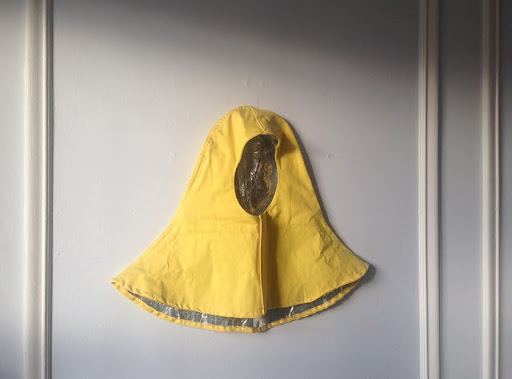
Cloth, aluminum foil, and adhesives.
21 x 24 x 6″. Courtesy of the artist.
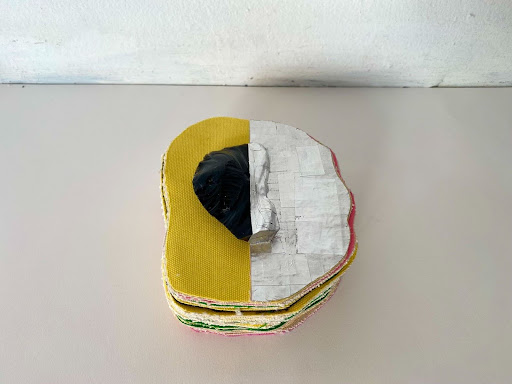
Cloth, aluminum foil, and obsidian.
Around 7 x 5 x 4″ inches”. Courtesy of the artist.
Hello, my name is Dianna Frid and as you can see I submitted two separate pieces for the exhibition Amuletto. The first piece is called Hood for Detecting Minor Planets and it was made in 2003 for an exhibition that I had at Gallery 400 that had a lot to do with asteroids. Many years later it seems I’m still working with similar materials except that in the case of the second piece, Colonel Outtakes, it was a piece that was made from the outtakes literally of a hole that I dug into cloth with a scissor and it has a piece of obsidian stone meshed within the cloth and it’s being held by the way in which I’ve been working with aluminum. Both pieces are significant in that they’re supposed to bring the wearer or the user protection and good luck. Gracias. Ciao.
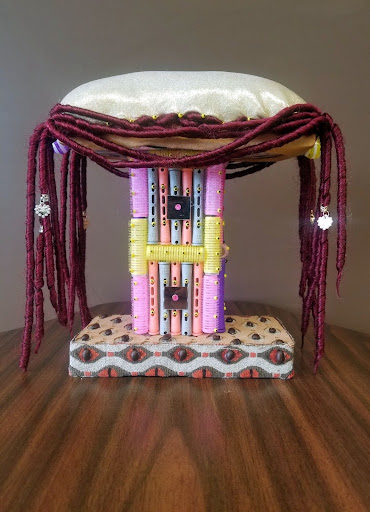
Fabric, hair bonnet, synthetic hair, rollers, pins, coffee beans, charms, and cork.
10W x 11H x 5D”. Courtesy of the artist.
Before my mother made her transition, my family and I had a conference call to discuss her burial wishes. Before this conversation, I had attended the exhibition at the Art Institute of Chicago titled The Language of Beauty in African Art, where I was reminded of how much I was enthralled with headrests, and they had them on display.
They seemed so uncomfortable to rest or sleep or lay your head on or neck on, but there I learned they were used for elaborate hairstyles to be maintained. So when I was asked to participate in the show Amuleto at the Hyde Park Art Center, in my research I found that the headrest was used as a funerary amulet in ancient Egypt. Either a miniature was made of the deceased headrest sewn into the mummy’s bandages, or the original was used to rest the mummy’s head.
This led me to reimagine a headrest, and I always felt grateful that my mother, my grandmother, and my aunt taught me how to take care of my hair and style my hair. And this custom I passed on to my children.
Inspired by headrests throughout Africa and Asia, used to preserve elaborate hairstyles, while sleeping, this led me to that uncomfortable memory of sleeping with rollers, bobby pins, and bonnets while tossing and turning, trying to get comfortable on that modern day pillow. So for me, in honor of my mother, this sculpture Pillow of Dreams is an amulet of a protector of dreams, and a reminder to rest, restore, and restart.
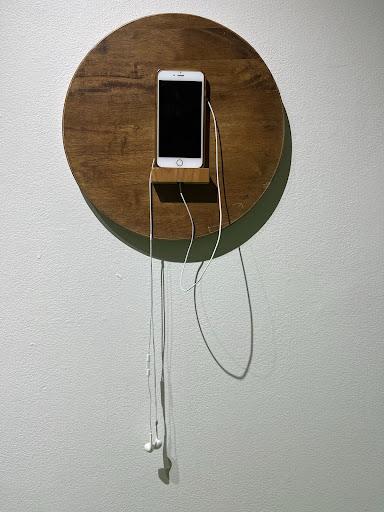
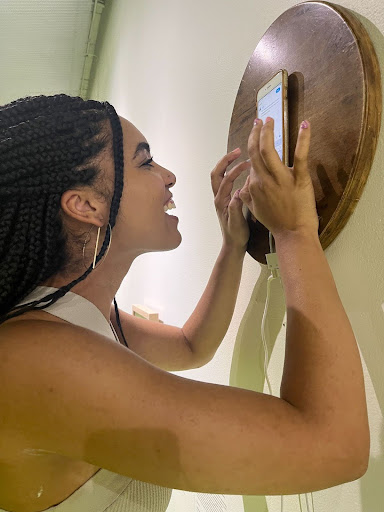
Wood, iPhone, Twitter, sound, and audience interaction.
12 1⁄2 x 12 1⁄2 x 3″. Courtesy of the artist.
I created the Modern Amulet as a response to the invitation to the show the Amulet and I was really thinking a lot about how something can give protection against evil, danger, or disease, and I was thinking a lot about the phone as a place of solace and connection that influences us, guides us, and protects us in some kind of way, and wanting to challenge the audience to step into that reality.
I also thought a lot about what the modern amulet is for people of faith, particularly Christians, and thinking about an amulet of ours is probably confession, and thinking of this anonymous Twitter feed as a confessional, as a way to express how this mode of technology continues to impact us daily.
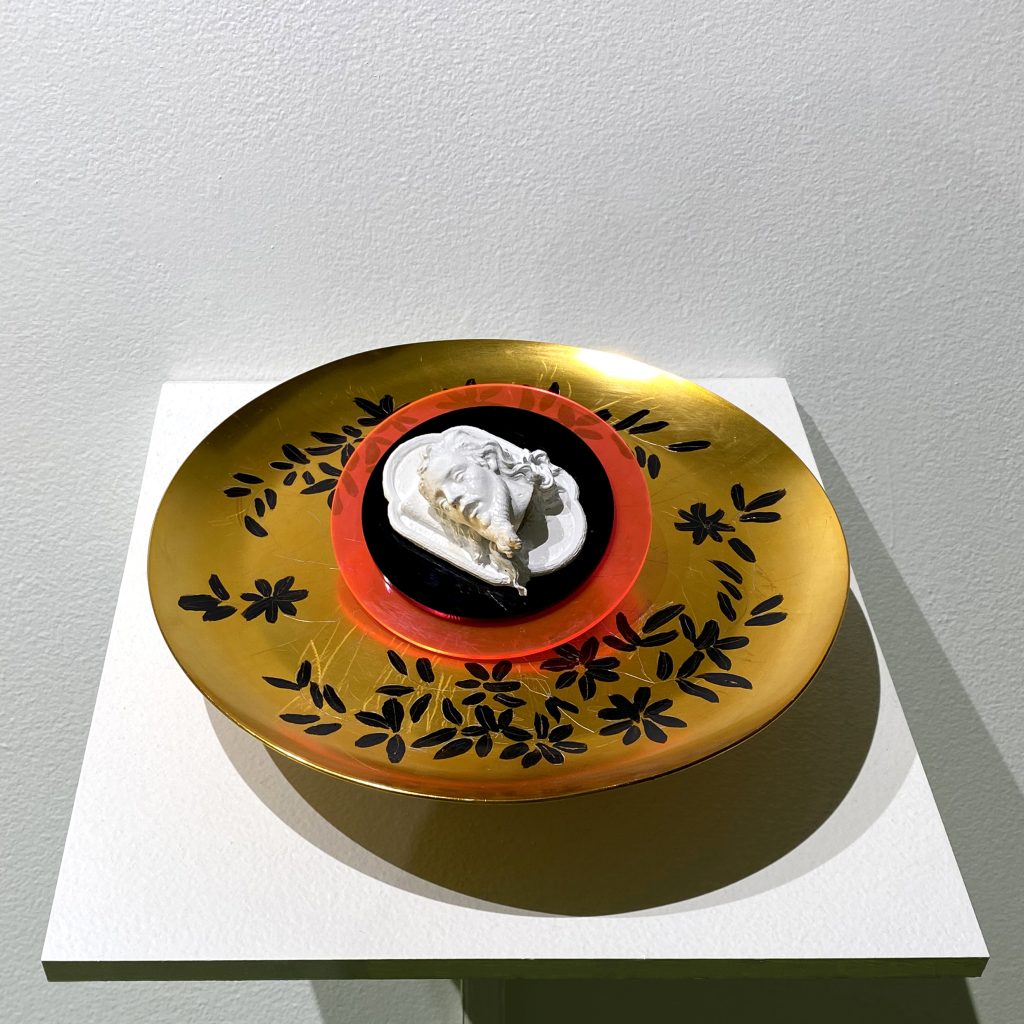
3D resin print, acrylic, brass, aluminum, paint, and engine.
10 x 10 x 10″. Courtesy of the artist.
Portrait Without Organs is a self-portrait that reflects on the nature of sacrifice and the idea of the body without organs proposed by Antony Artaud in his work The Theatre and its Double.
Artaud proposes that the human body is trapped in an organ system that limits and conditions it. The body without organs is a way to free ourselves from this system and reach a state of abundance and freedom.
The 3D-scaled model prints in white resin contrasts with a golden tray decorated with black floral motifs giving the whole a spiritual and ceremonial sense. Like the Baroque, the aesthetic is presented through a dramatic use of light, shadow and intense form. Exaggeration and contrast create a striking effect in the theatricalization of the scene.
The idea of relics is represented in traditional objects that are linked to memory, a person, or a sacred event. The relic has been venerated for centuries and is said to have healing power in the context of charms and magical objects. The work is conceived as a symbolic representation of faith and hope.
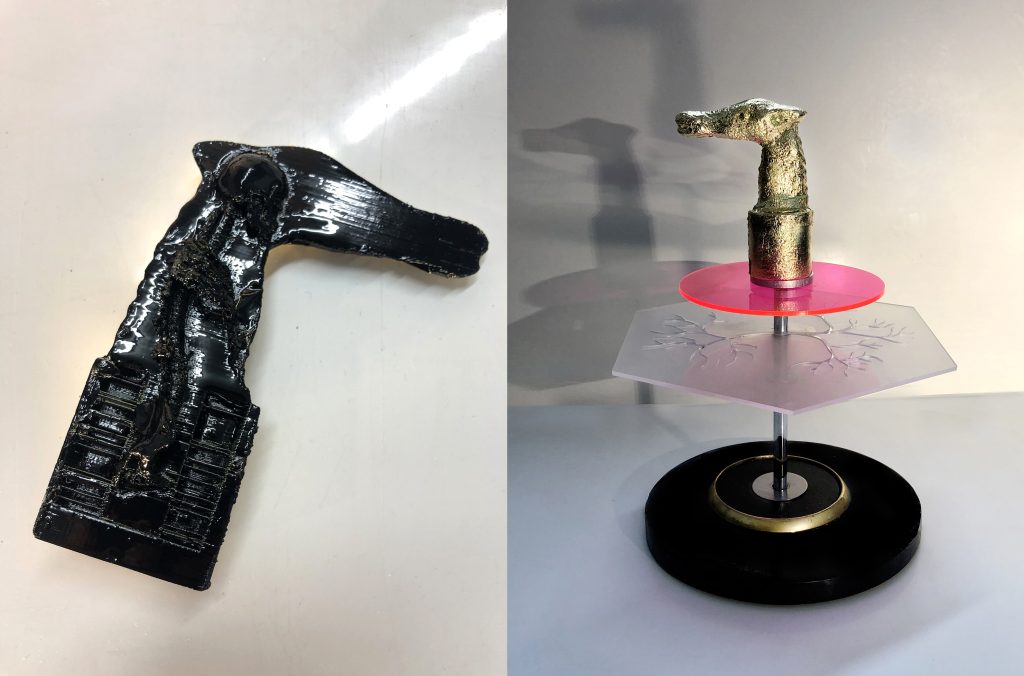
Canope Head is a piece that explores the age of the magical object and its protection. The work was made from a series of 3D scanned objects that family and friends sent me during the months of confinement in 2020.
The use of 3D scanned objects is a way to capture the essence of loved ones who lived at a distance during those difficult days. These objects are unique and special and their presence in the work gives it a personal and emotional meaning.
The hexagon is a geometric shape frequently found in nature and associated with human biology. The circle is a symbolic form of protection. In many cultures it represents unity, wholeness, and security. In this case the circle represents unity and therefore protection.
This amulet is a piece with a magical attribute that represents love and protection for our loved ones in circumstances of fear and pain.
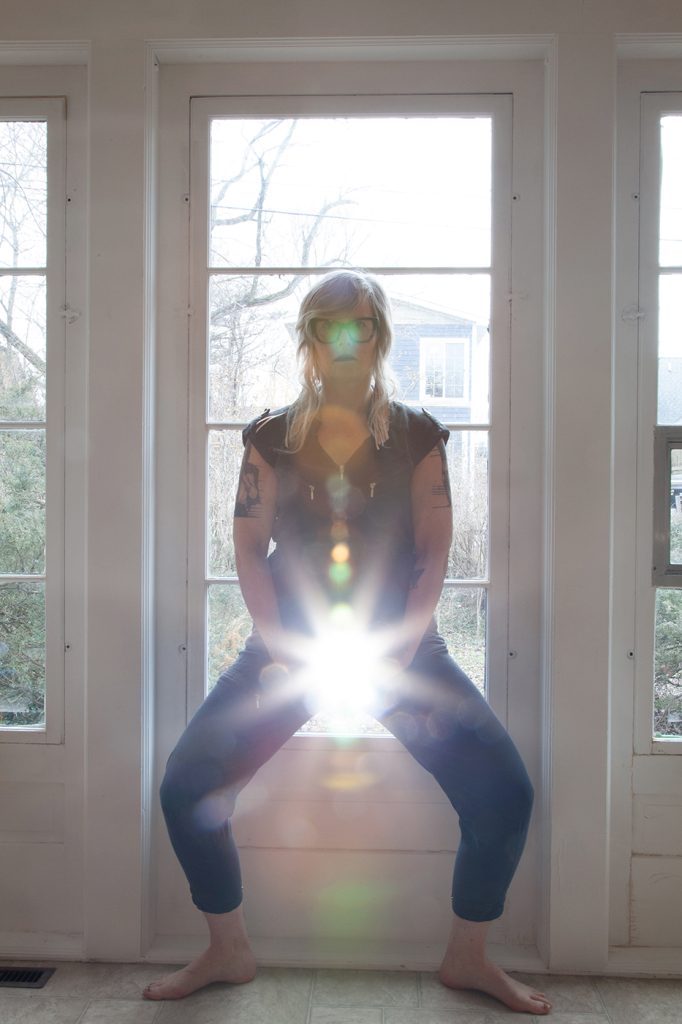
Mounted and framed archival inkjet print.
15 x 11″. Courtesy of the artist.
The precise origin and meaning of the Sheela-na-Gig remains unknown. Historians generally believe they were made between the 11th and 17th centuries. These nude figures, with exaggerated and wide open vulvas, can be found on churches as well as secular buildings, mainly in Ireland, but also in the UK, Spain, and France. They are usually placed above windows, doorways, or on gates to guard passageways and openings. Most historians believe Sheelas are a pre-Christian fertility goddess or folklore talisman intended to provide protection against evil and ensure safe and healthy childbirth. This self-portrait as a Sheela-na-Gig is a powerful gesture of rebellion against the patriarchy and a modern-day protector of femme bodies from the fascists who have banned and criminalized abortion, stripping us of our right to control our own bodies.
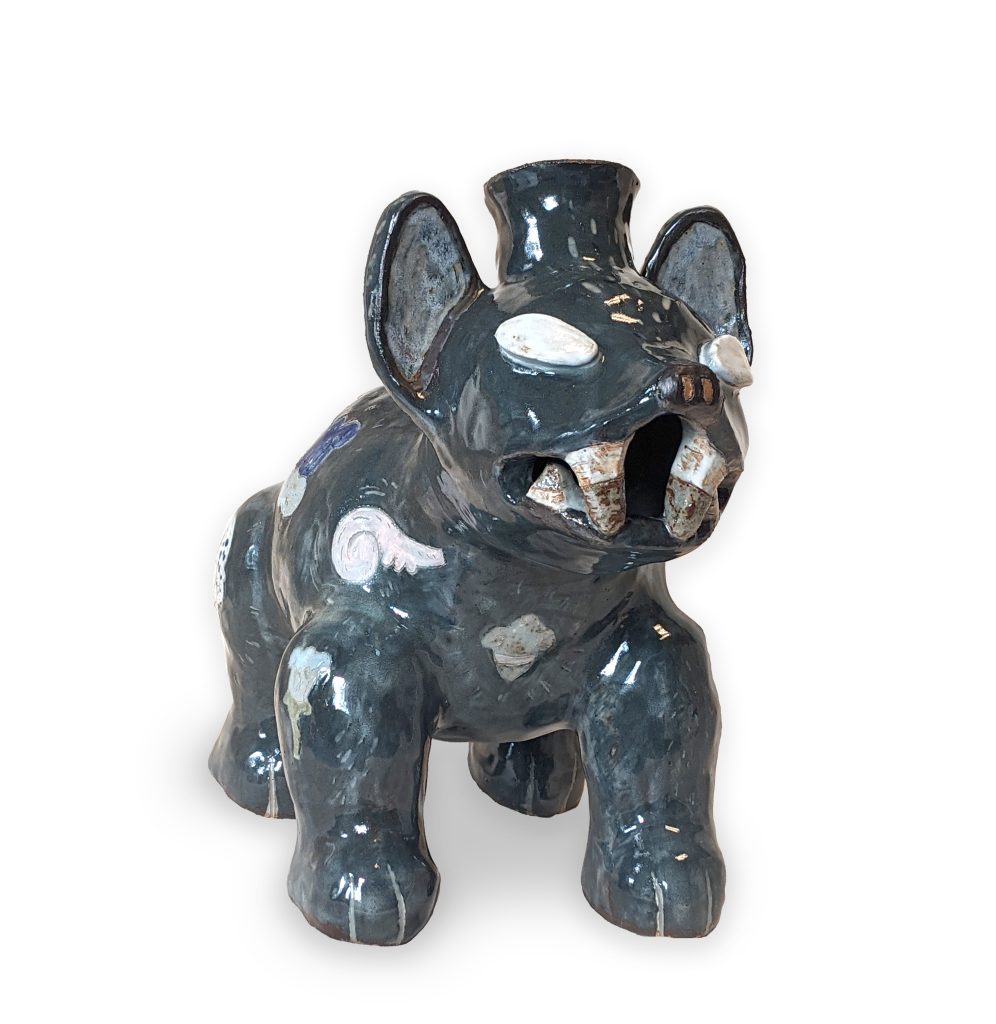
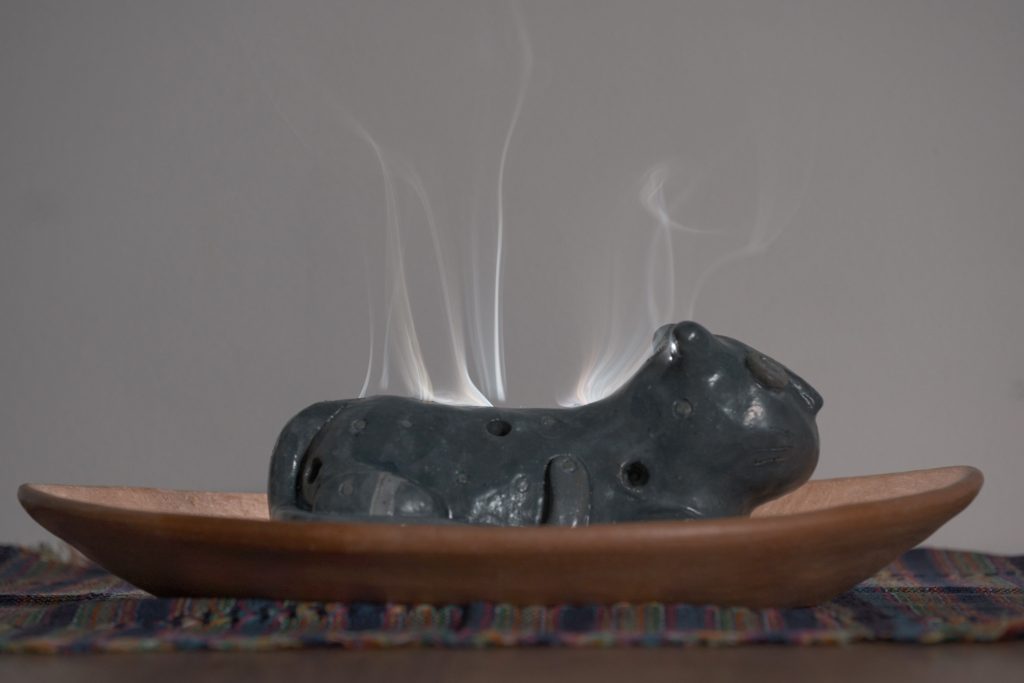
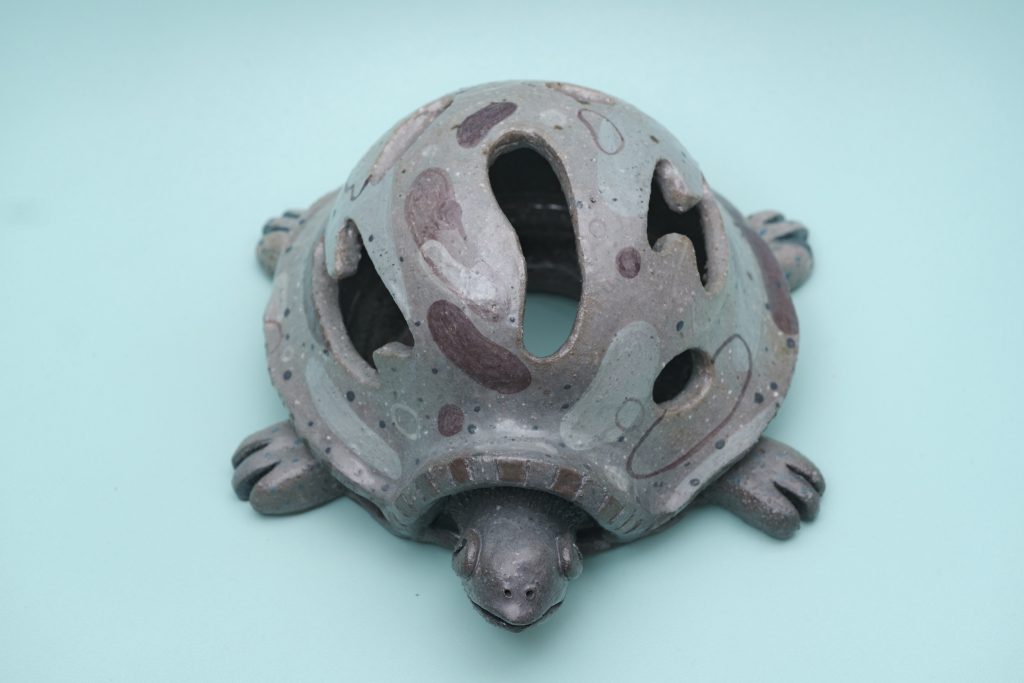
High-temperature ceramics.
4 x 8 x 7″. Courtesy of the artist.
These three ceramics are part of my ongoing project of developing a personal speculative mythology.
They are all spirit animals, a turtle, an ocelot which is an animal similar to a jaguar, and a xolo which is a Mexican dog. They are all charged with symbolic meanings particularly in pre-Hispanic Mexican cultures. Turtles are associated with patience, longevity, and endurance. Jaguars are associated with strength and agility, and xolos were the guides to the dead world.
These sculptures are a sort of talisman and also an offering They are reminders of the strengths and qualities that we want to pursue.
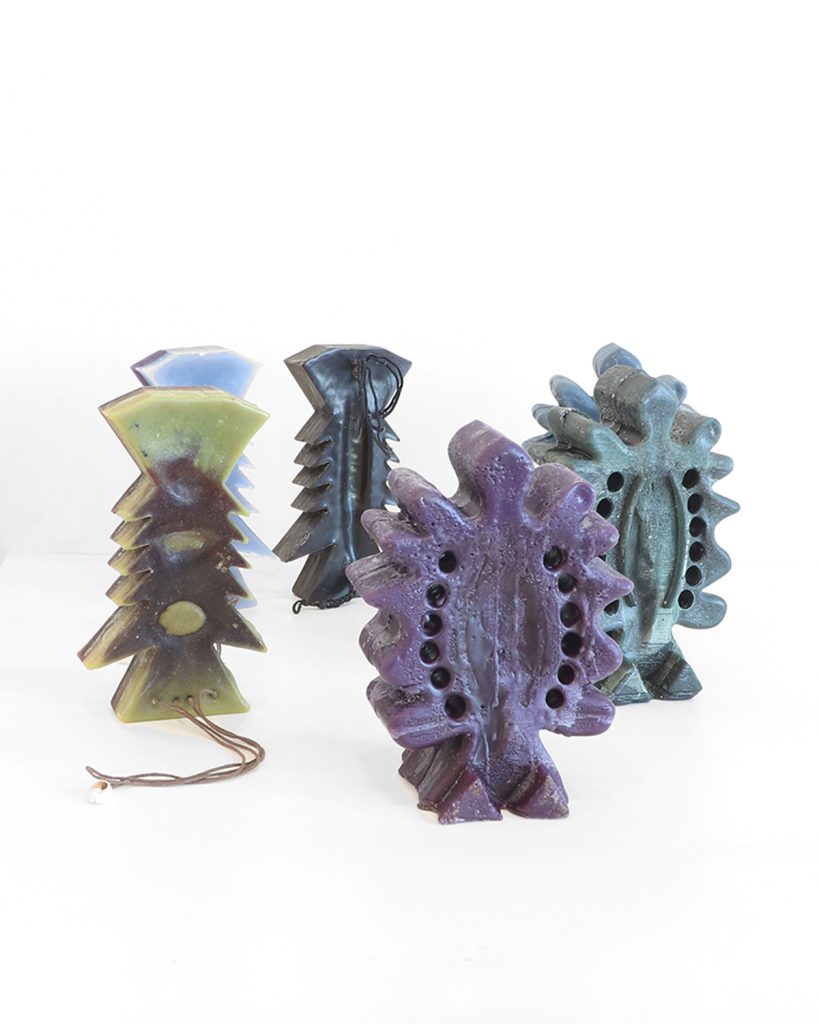
Necklace, paraffin, pigment, and mica powder. Courtesy of the artist.
An amuleto for me is an object that is made. It can be found. It’s an object you become familiar with and can recognize it in different places.
The function of an amuleto is to guide you, to protect you. In this case this amuleto is preserving raw material for any moment that is necessary to be used, to be transformed into a functional, useful object, like a candle. That’s what this amuleto is, it has a shape which is very familiar to me. It has been transformed starting from a brick.
An amuleto is also an object that keeps evolving depending on the needs or requirements of the person who has it.
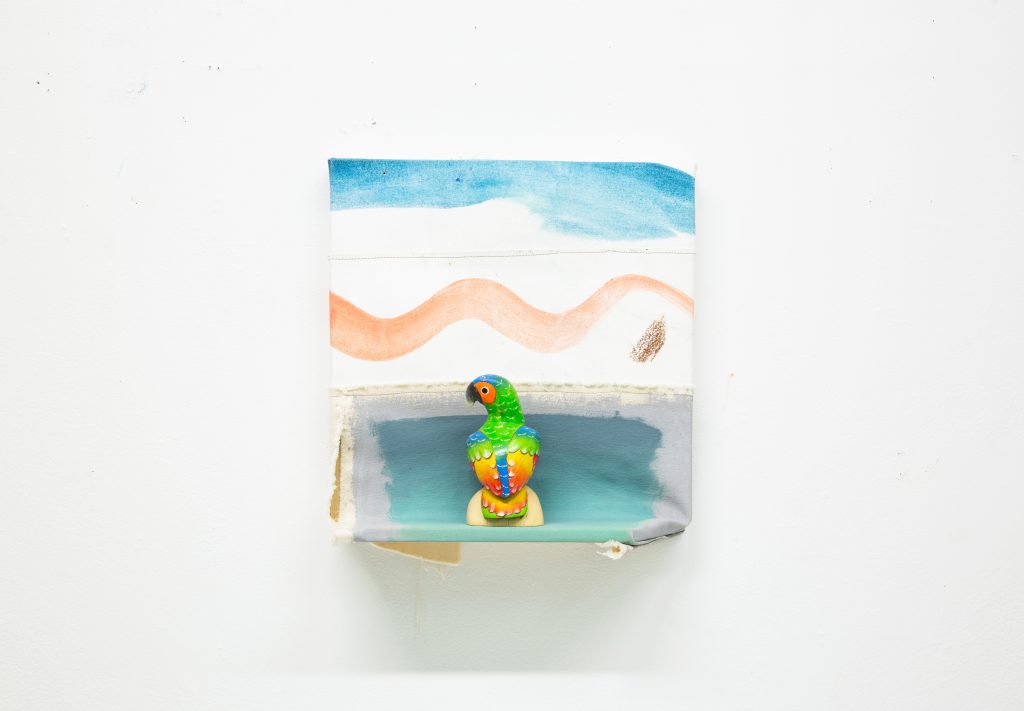
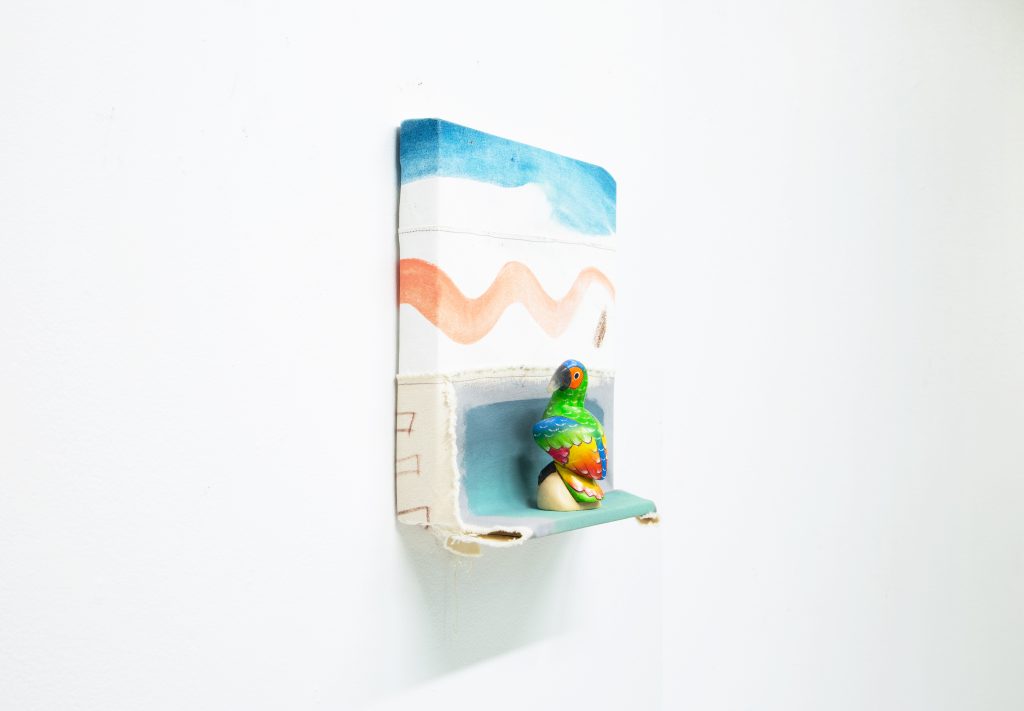
Balsa wood bird gift from artist’s father, oil, and acrylic on canvas.
14 x 14 x 5″. Courtesy of the artist.
When thinking of an Amuleto, I think of an object that can be taken around and is mobile. With this work, Forward and Back I am thinking about distance and how this object, which came from Ecuador, was brought in by my father and was kept with him for a long time. It was then passed down to me.
It is an Amuleto also because there is this adornment in the object, it has multiple colors and it is further adorned by the container or outer that takes on a form of a painting as well.
I often think of objects as things that you can present in a way to archive or keep permanent in some space, right? Because when an object is put in space it has a function, but when it’s taken out of space, it is taken out of the ordinary. It is taken out of the everyday, it becomes a relic, it becomes something more.
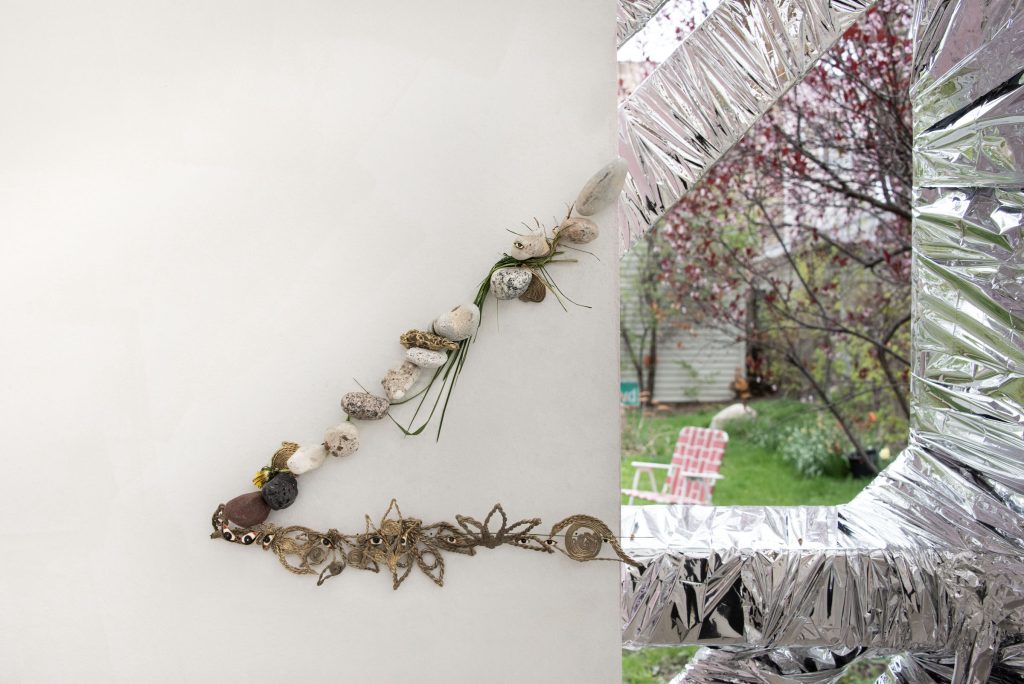
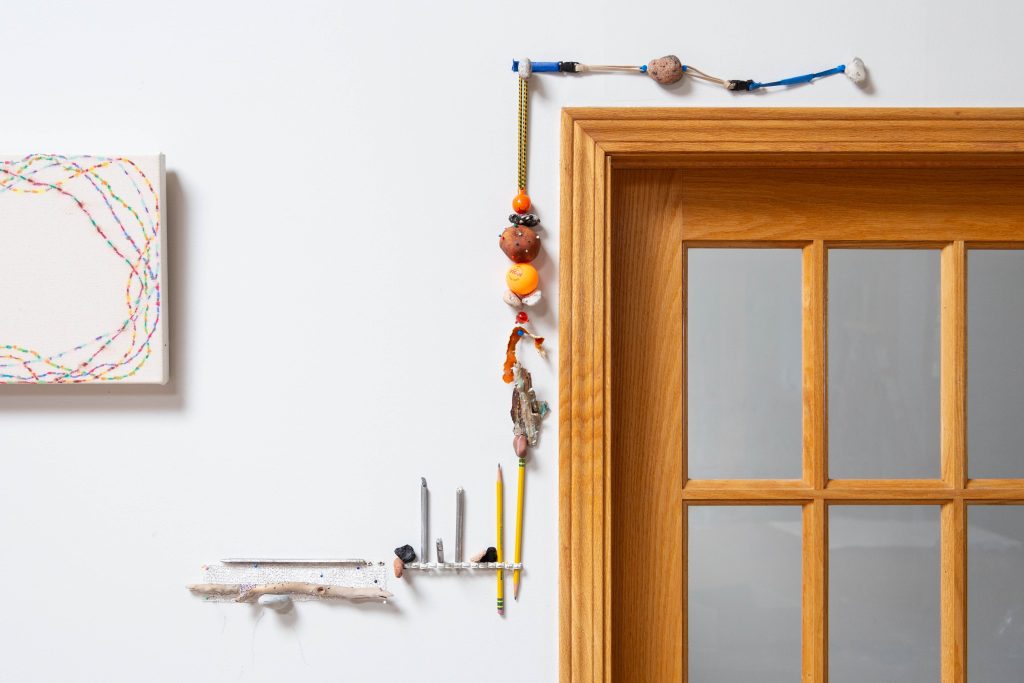
Mixed media.
75 x 6 x 3″. Courtesy of the artist.
For Amuleto, I showed three separate site-specific installations from a series titled Glyphs of a Temporal Landscape. The work is made up of different stones, debris, and organic matter that I collected during my walks and travels. Some objects that I found on site and a few that I made in my studio during my material inquiries.
At Hyde Park Art Center, there were rocks collected from the lake shore along with miniature play toys. There was one where a miniature man was inside a capsule and then was resting at the edge of a stone, almost like it was overlooking a cliff.
The one at the Franklin featured eyes made from brass, along with other found objects and then grass from the garden.
At Mayfield, there were studio supplies such as pins, clips, rubber bands which were also combined with cast pencils from my studio and orange peels.
In each installation, the objects are arranged in a line that responds to the location itself. I am interested in arranging objects next to each other that are often mimicries of each other. Hand made and found objects together emanate their presence, histories, and an accumulation of their time and habit.
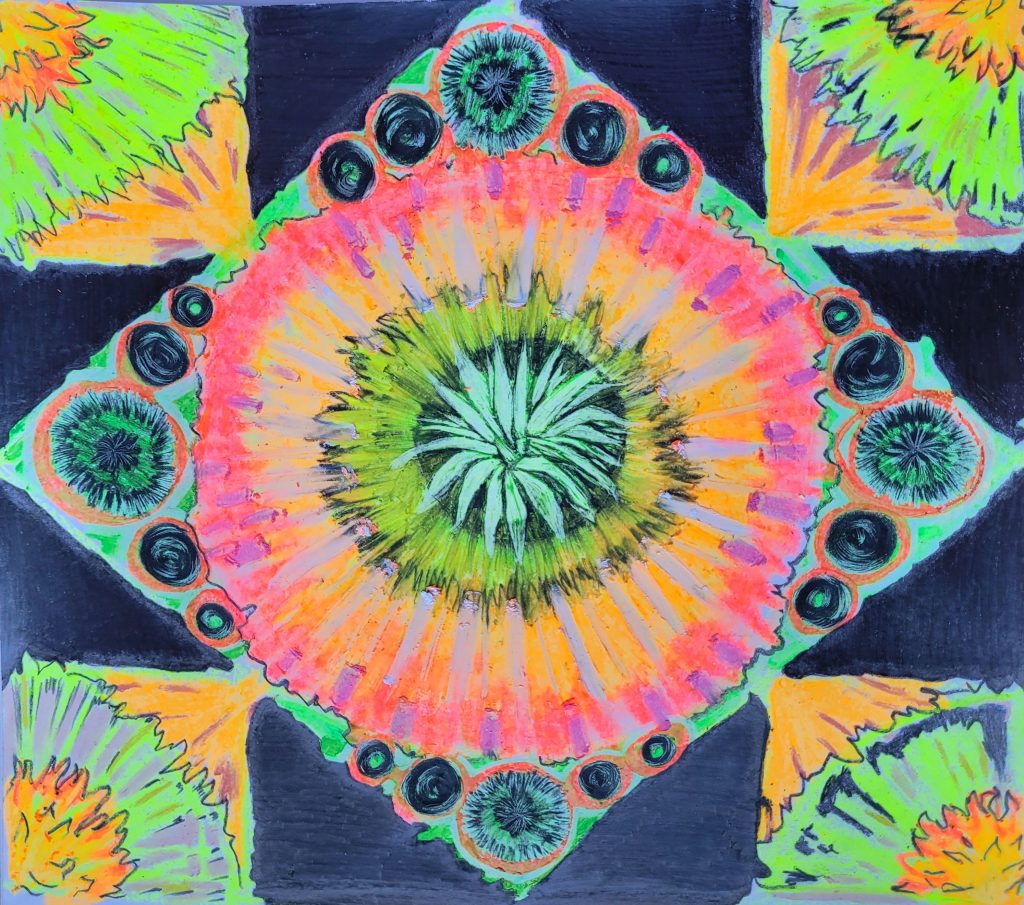
Graphite and oil pastel on paper, 9 x 8″ (unframed). Courtesy of the artist.
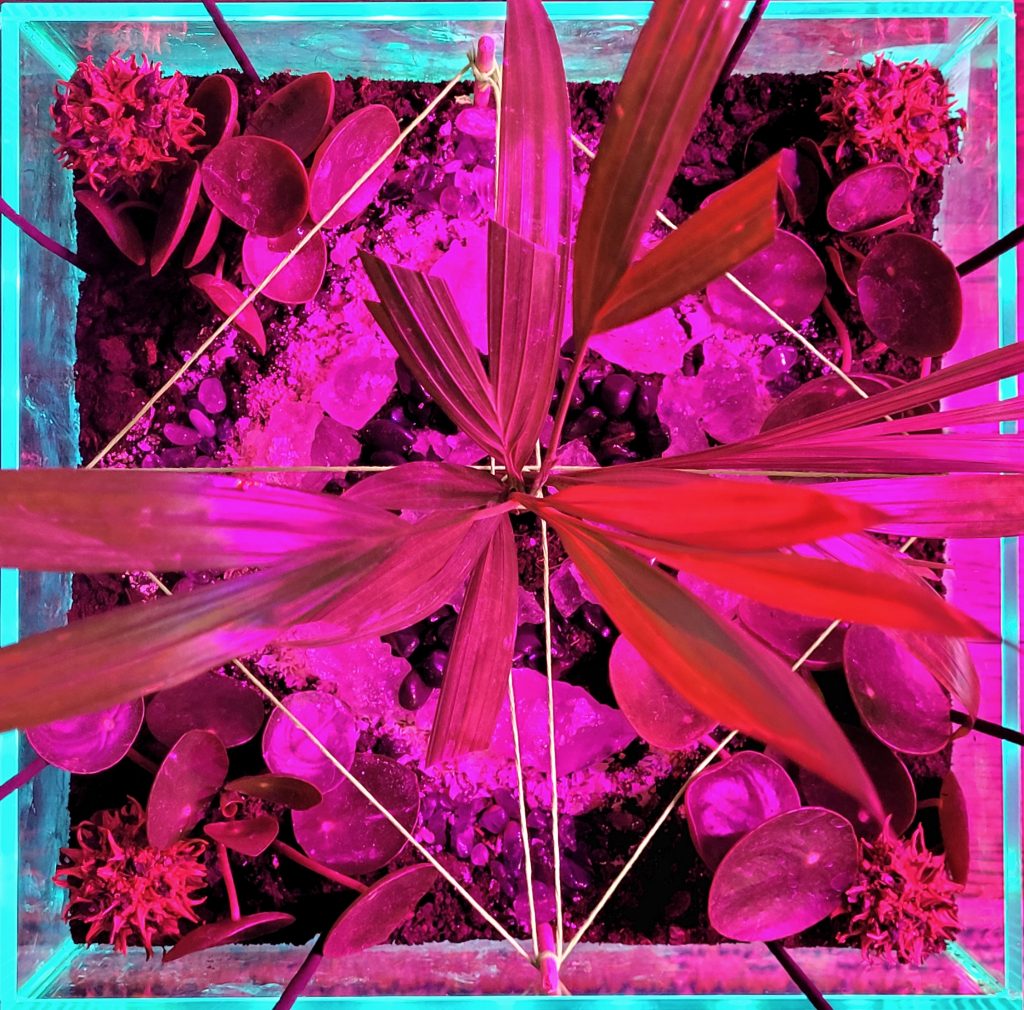
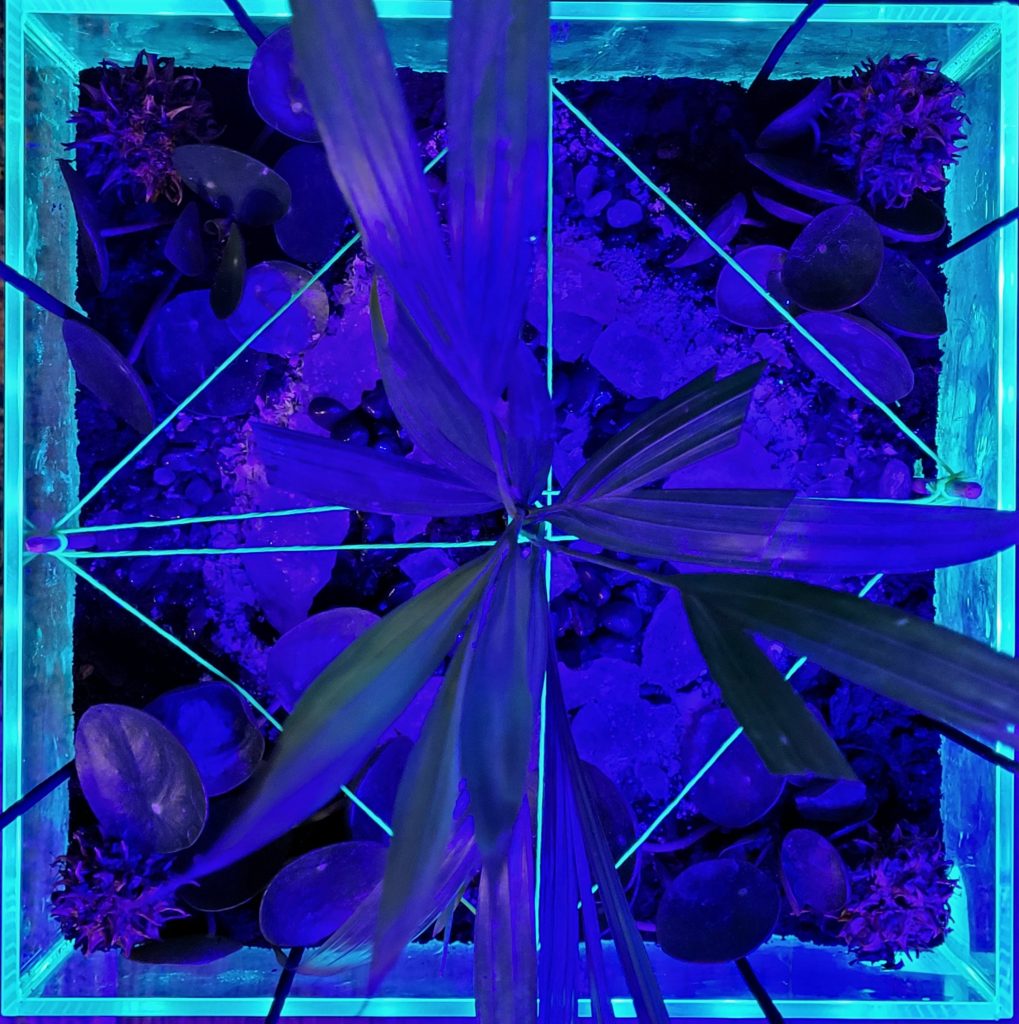
A photograph of a terrarium seen from above illuminated by a black light.
10 x10 x 13″. Courtesy of the artist.
In Latin America, we are a people of Indigenous, European, and African ancestry; But This is not just about our genetic make-up. Raised in Colombia by my grandmother and aunts, I observed many healing rituals informed by our multiculturalism.
I have vivid memories of aloe plants hanging in corners of rooms, as well as eggs and lemons sitting under our beds for protection, lentils and rice scattered behind our doors for prosperity, basil and other herbs cure emotional and physical pains. Accessing these healing powers can come in the form of a tea, a bath, or smoke. Either way, it is all about invoking the protection of a higher energy.
I no longer live in Colombia or with these relatives and have lost a lot of these traditions. As of late I have been trying to reconnect with these rituals. It all has begun to merge with my creative practice in the form of growing plants and connecting with something larger than myself. Just like my grandmother, I too have taken to growing, caring, and respecting nature’s protective and healing properties.
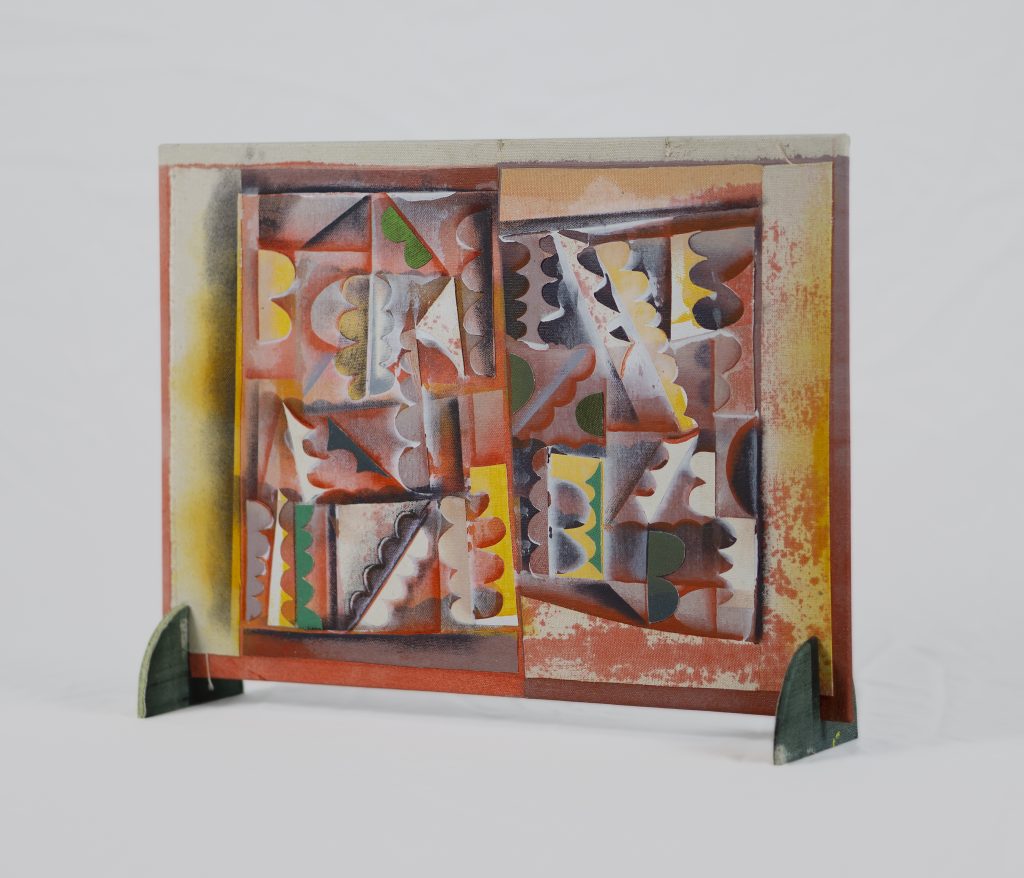
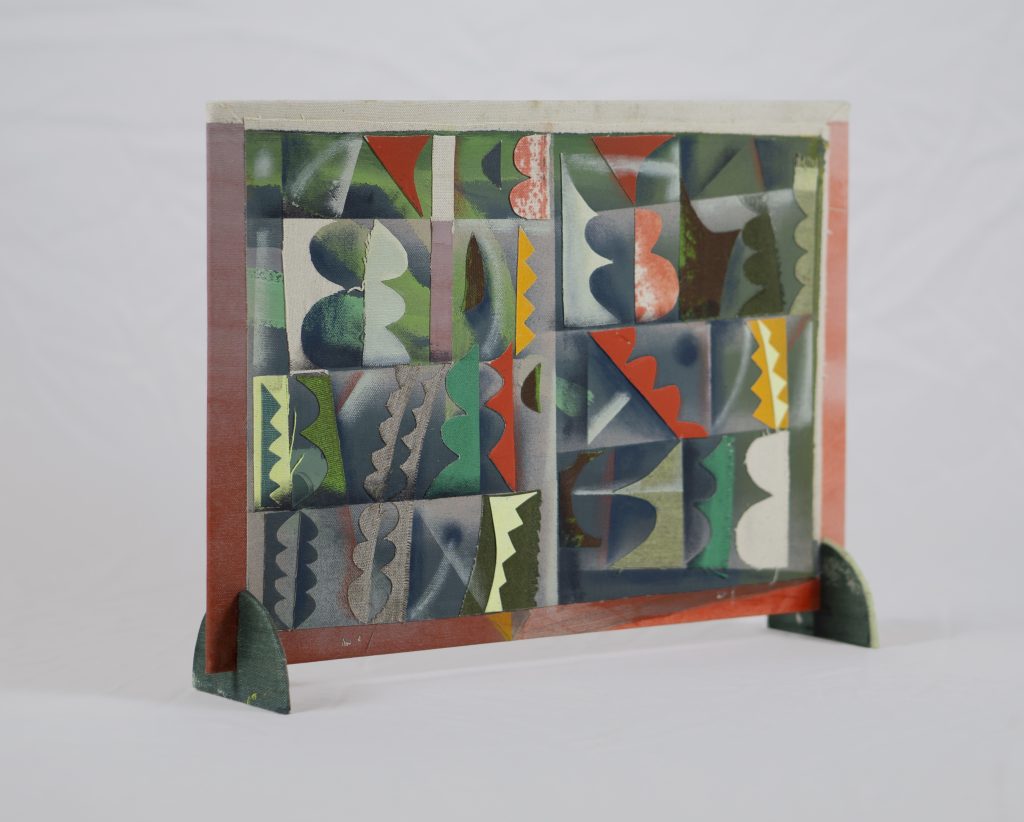
Acrylic, collage, wax pastel, and canvas on book board, two sided.
12 x 16″. Courtesy of the artist.
It’s funny to be asked for a story about the work I included in Amuleto because the works actually look like they could be stories. They’re images that resemble open books and are actually painted on canvas-covered book boards, and they look like text. However, they’re indecipherable and unknowable.
I’m going to just read the artist statement that I wrote for the show and let that stand in for its story. Plants are writers inscribing the world with endless, profuse language. In their world, also our world. Outsides are undersides are insides. And there are always also insides inside insides.
These freestanding book glyph paintings are like picture writing with plants. Desire portals into a vegetal place. Their replicating, reversing forms simulate alphabets and grammar, channeling unknown intelligence.
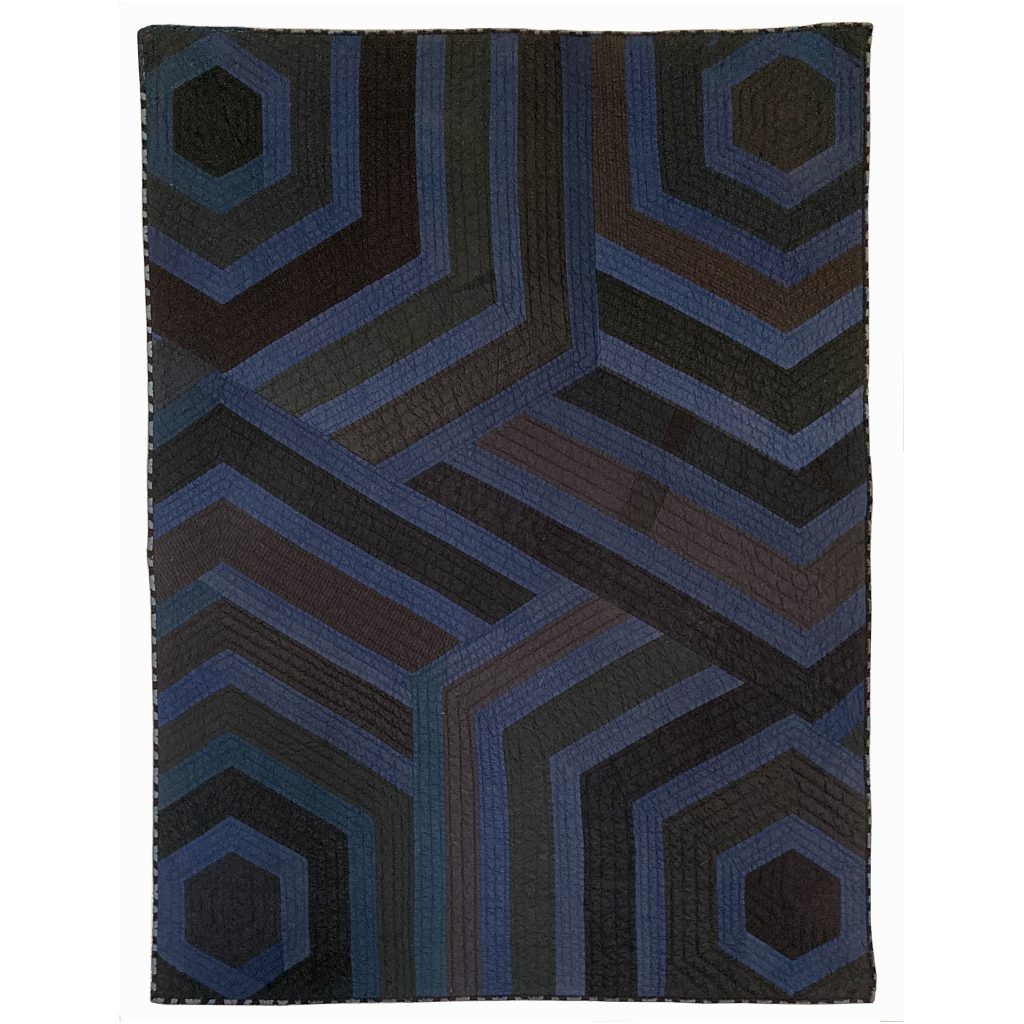
Vintage Japanese indigo-dyed cotton and other 100% cotton recycled and new material, machine pieced, and hand quilted.
72 x 60″. Courtesy of the artist.
During the pandemic, I began working on a project that involved figuring out simple ways to draft the polygons essential to quilt making using only paper, pencil, and a straight edge. In need of help, I asked my father, who is a mathematician, to help me revisit some basic geometry and critique my methods. I’d never really talked math with my dad before, but this discussion developed into a long back and forth about quilt geometry that included many phone calls and emails.
It was a very special opportunity to connect our two fields of interest and to connect on a personal level as we weren’t able to be together in those days of lockdown. I made this quilt after my father died in 2021. It’s a response to these conversations.
When I showed my dad the method I had developed for drafting a hexagon, the shape on which this quilt is based, he was impressed with my method but told me that I needed to call my shape a quote hexagon using quotation marks because it wasn’t accurate enough to hold up mathematically. The quotation marks in the title of this quilt are an acknowledgement for him of the difference between quilt math and real mathematics.
This is the only quilt I’ve ever made that is expressly meant for my own bed. It embodies ideas of warmth, care, knowledge, memory, and family. The fabrics are a combination of vintage Japanese indigos, men’s shirts, and a strip of African wax print that is covered in eyes, a reminder that my dad is always watching over me.
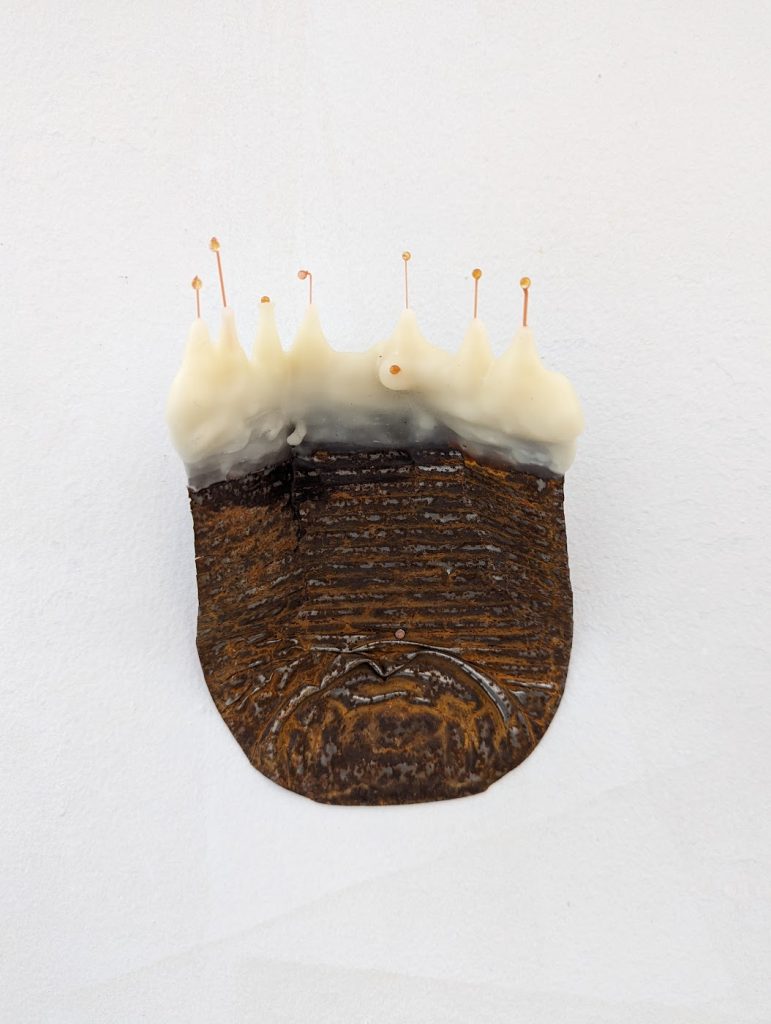
Metal, paraffin, and wax. Courtesy of the artist.
Patitas is an ongoing series focusing on found decaying objects. Mystified by their unknown narratives told through their patinas, their colors, their textures, I give them a new existence through play. The beauty of each object’s deterioration heightens awareness of their environments, which refreshes my curiosity about how they arrived and how I might interpret those origins.
This series has allowed me to deeply explore an idea that has always fascinated me on how we all decide what does and what doesn’t pike our curiosity.
In this specific piece that was shown in the Franklin, the patitas are facing up, so it’s patitas pa’rriba.
| This article was made with the support of Hyde Park Art Center, The Franklin, and Mayfield. I want to thank Tran Tran and Allison Peters Queen for their helping hand and each artist for their trust. |
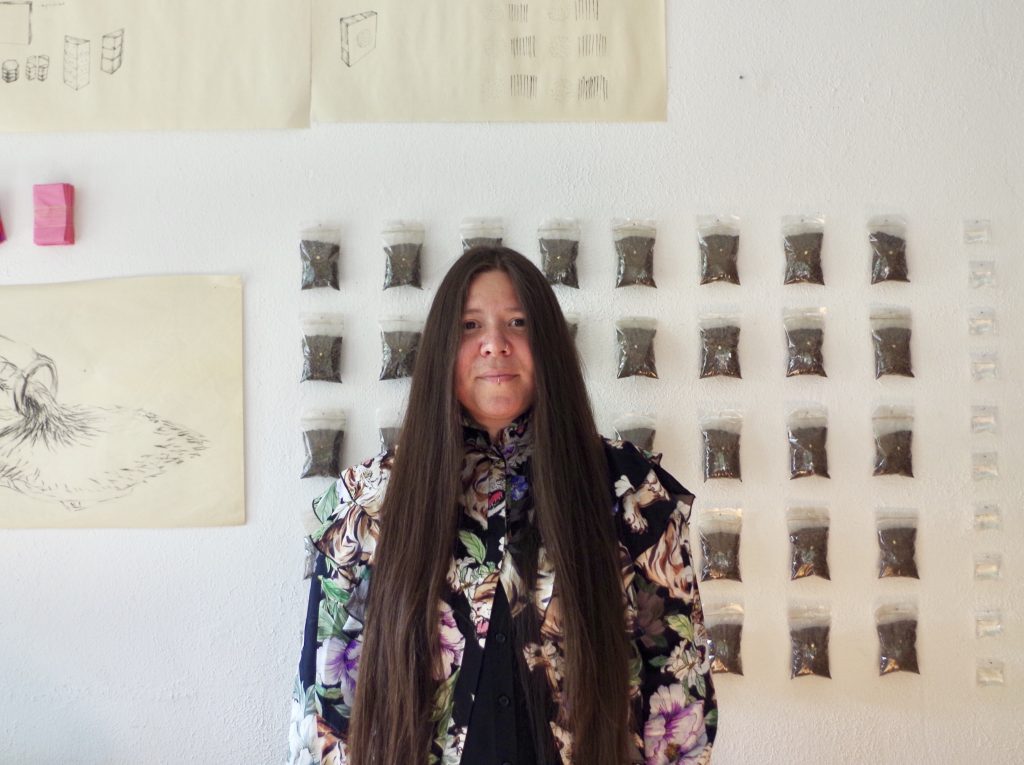
About the Author: Natalia Villanueva Linares is a French Peruvian moment maker living in Chicago and working between North + South America and Europe. His artistic practice oscillates between the monumental feel for volume of her installations and participatory performances.
Natalia is also a cultural worker, she co-founded the non-profit organization Yaku in Peoria IL. She is the former Director of the mini mansion High Place and founder of the magazine Ukayzine, created to promote international cultural exchanges through the visual Arts.
With Sixty Inches From Center, Natalia contributes as a translator, she created the series “Desde los Archivos” and worked as an organizer for the critic program CANJE, an exploration in cultural criticism.



